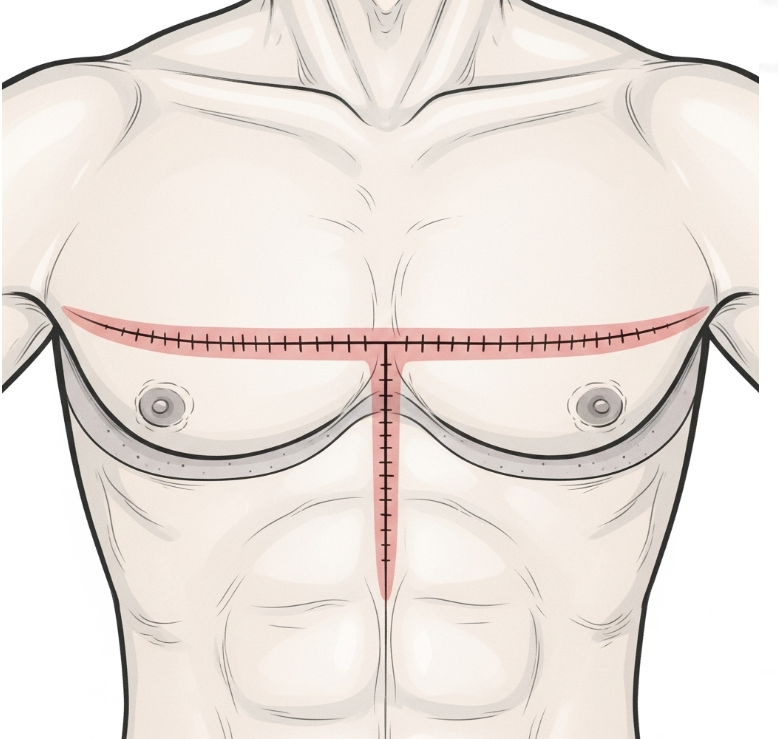Treatment Overview
T-Anchor Top Surgery (also known as the Anchor or Wise-pattern mastectomy) is a gender-affirming chest masculinization procedure designed for patients with very large chests, significant sagging (ptosis), or excess skin from weight loss. It combines horizontal and vertical incisions to create an “inverted T” or anchor shape, allowing surgeons to remove large amounts of tissue and skin while reshaping the chest into a flat, masculine contour.
In Korea, surgeons are recognized for their expertise in complex chest reconstruction and scar management, using refined suturing methods, advanced aftercare (laser scar treatment, RF therapy, silicone patches), and 3D planning to deliver natural, balanced results. For patients who need maximum skin removal and nipple resizing, T-Anchor is often the most effective option.
Purpose & Benefits
- Chest Masculinization: Flattens the chest even in very large chest sizes.
- Excess Skin Removal: Ideal for patients with sagging or post-weight loss skin.
- Nipple Resizing & Repositioning: Nipples are resized and grafted for masculine placement.
- Improved Chest Contour: Corrects ptosis and lateral fullness more effectively than other methods.
- Permanent Results: Removes breast tissue permanently.
- Gender Affirmation: Provides life-changing results for patients seeking alignment with gender identity.
Ideal Candidates
- Trans men, non-binary, or gender-diverse patients with large chest sizes (C–DD+).
- Individuals with significant sagging due to age, hormones, or weight loss.
- Patients unsuitable for keyhole, periareolar, or standard double-incision surgeries.
- Adults in good health and stable weight.
- Non-smokers or those willing to quit before surgery.
- Patients with realistic expectations regarding longer, anchor-shaped scars.
Possible Risks & Complications
- More visible scarring compared to other top surgery techniques.
- Temporary swelling, bruising, or soreness.
- Nipple graft complications (partial loss, pigment changes, sensation changes).
- Contour irregularities or asymmetry.
- Rare risks: infection, hematoma, or delayed wound healing.
Techniques Used
- Inverted-T / Anchor Incision: Horizontal incision along chest fold + vertical incision from areola downward.
- Breast Tissue & Skin Removal: Allows for large-volume removal.
- Free Nipple Graft (FNG): Nipples removed, resized, and repositioned for symmetry.
- Liposuction (Optional): Contours side chest and underarm for smoother results.
- Scar-Minimizing Closure: Layered sutures and scar therapies to reduce visibility.
Recovery & Aftercare
- 1–2 weeks: Swelling and bruising peak, then improve.
- 2–3 weeks: Return to desk work and light daily activity.
- 4–6 weeks: Resume light exercise (avoid chest workouts initially).
- 3–6 months: Chest contour refines; scars begin fading.
Aftercare Guidelines:
- Wear a compression vest for 4–6 weeks to reduce swelling.
- Avoid heavy lifting and chest strain until cleared.
- Follow scar-care program (silicone sheets, ointments, or laser).
- Protect scars from sun exposure to prevent darkening.
- Attend follow-ups for wound checks and possible scar refinement treatments.
Results & Longevity
- Flat, masculine chest contour even for very large chests.
- Permanent tissue removal with long-term results.
- Masculine nipple placement and proportion.
- Anchor-shaped scars (fade over time but remain permanent).
- Significant improvement in body confidence and gender affirmation.
Treatment Process in Korea
1. Consultation & Planning
- Surgeons assess chest size, skin elasticity, and sagging level.
- Surgical plan designed using 3D imaging and nipple graft positioning.
2. Surgery Day
- Performed under general anesthesia.
- Horizontal and vertical incisions made in anchor pattern.
- Breast tissue and excess skin removed.
- Nipples resized, repositioned, and grafted.
- Drains may be placed for healing.
3. Post-Operative Monitoring
- Compression garment applied immediately.
- Hospital stay usually 1–2 nights, depending on surgery extent.
4. Follow-Up & Refinement
- Follow-ups at 1 week, 1 month, and 3–6 months.
- Scar-care sessions included (laser, RF, or microneedling if needed).
Why Korea is a Top Destination
- Surgeons with extensive experience in complex chest masculinization.
- Use of scar-minimizing techniques and advanced closure methods.
- Clinics offer comprehensive aftercare (scar therapy, massage, RF, laser).
- More affordable than Western countries while maintaining world-class standards.
- International-friendly clinics with multilingual staff and discreet LGBTQ+ care.
Cost Range
The cost of T-Anchor Top Surgery in Korea depends on chest size, complexity, and clinic reputation.
Estimated Pricing:
- Standard T-Anchor Top Surgery: USD $9,500 – $13,000
- With Free Nipple Graft: USD $10,500 – $14,500
- With Liposuction Refinement: USD $11,000 – $15,500
- Premium Clinics (scar-care + 3D imaging + VIP aftercare): USD $13,000 – $18,000
Additional Costs:
- Consultation & pre-op testing: USD $200 – $500
- Compression vest: USD $150 – $300
- Scar-care program (lasers, silicone, RF): USD $300 – $1,000
- Medications & aftercare: USD $200 – $400
Popular Clinics
- Banobagi Plastic Surgery (Seoul): Known for anchor-incision top surgeries with refined contouring.
- ID Hospital (Seoul): Specialists in large-chest masculinization and nipple graft techniques.
- JK Plastic Surgery Center (Seoul): JCI-accredited, offering premium aftercare programs.
- View Plastic Surgery Clinic (Seoul): Experts in scar refinement with laser and RF therapy.
- JW Plastic Surgery (Seoul): Leaders in T-Anchor procedures for post-weight loss and large chest patients.




